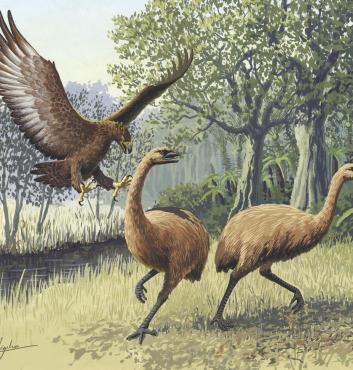On Walkabout At: The Taupo Museum
A great place to start any tour to the Taupo area would be by going to the Taupo Museum which is located right next to the information center that is easily visible from the road into town. The museum gives an excellent depiction of the historical, cultural, and natural significance of the Taupo area:
The first settlers of the Taupo area were not Europeans but the Maori people who immigrated from Polynesia around 1000AD. The settling of New Zealand was the last major habitable land mass to be settled by humans. Here are some portriats of Maori from the Taupo area:
The first Maori called the new land mass Aotearoa. The early settlers were amazed by many things they found on the island such as the many exotic animals. One of the more well known exotic animals to the Maori was the Moa bird:
The moa at the time was the world’s largest bird and provided an easy food source for the Maori. By the 1500’s the bird was extinct from over hunting and the gathering of the moa’s eggs for food. The extinction of the moa led to the extinction of another exotic animal the Haast Eagle:

This eagle was the world’s largest eagle and depended on the moa for its main food source. It is also suspected that the eagle may have also hunted unsuspecting Maori people but the Maori would have eventually been able to adequately defend themselves from these massive eagles thus reducing them as a potential food source.
Many of the early exotic animals like these birds are now extinct, but some of them like New Zealand’s world famous kiwi birds still exist to this day though they are an endangered species:
The first Maori settlers made their homes along the coast and as the population increased more land had to be settled in the interior. The remote Taupo area was the last area of the North Island to be settled which occurred sometime in the 16th century. The first Maori to explore the area was a man by the name of Tia. Tia named the lake Taupo because as he explored the lake a large “cloak” of darkness descended over the lake. Taupo is the Maori term for “cloak”.
Eventually Taupo became a heavily settled area for the Maori who used the lake as a highway to get quickly from area to another using their massive canoes:
The Maori lived in simple wooden homes and the museum has a reconstruction of an example of a Maori meeting house:
Besides the meeting house the museum has many displays of Maori artifacts like the weapons and tools they used in every day life:
The Maori in the Taupo area did not have contact with Europeans until the 19th century and a permanent settlement was established until 1870 when where the modern day town of Taupo now stands a military outpost was constructed in the wake of the New Zealand Wars in the 1860’s which pitted the British empire against the Maori. Most of the early settlers that came to Taupo after the founding of the outpost were involved in the timber industry which is still a major industry to this day.
Besides the town’s Maori and European history the museum also has a good display on the area’s volcanic history:
The nearby Tongariro National Park has three massive volcanoes that continue to be active to this day. The largest and most active volcano, Mount Ruapehu which is also the highest point on the North Island at 2,797 meters, just recently erupted in 2006 and continues to pump ash into the air from time to time to this day. Lake Taupo itself is the remains of a huge volcanic caldera after a massive eruption. The caldera over the years filled with water from the melting snows of the volcanoes of Tongariro National Park. Along the shores of the lake there are warm beaches from the heat of the caldera that warms the lake to this day.
The final thing to check out is the Garden of Well Being that is located outside the museum:
The garden was constructed with donations that totaled $230,000 dollars. In 2004 the garden won the Chelsea Flower Show which is supposed to be the equivalent of the flower Olympics. It is a pretty nice garden but it is hard to imagine that it cost $230,000 bucks to create. However, the museum itself is definitely worth checking out in order to get a better understanding of the historical, cultural, and natural significance of this beautiful area of New Zealand.
Next Posting: The Craters of the Moon
Prior Posting: Taupo Hotel Recommendation












[…] bones signs warning about hazardous volcanic gas earlier and I also remember when I visited the Taupo Museum, reading a newspaper article they had posted about a man that was rescued by fellow climbers on […]